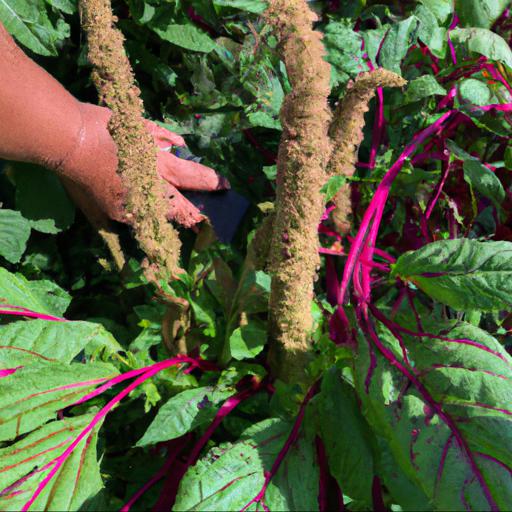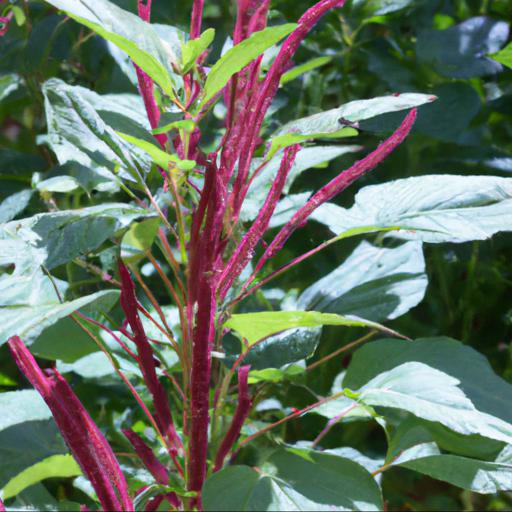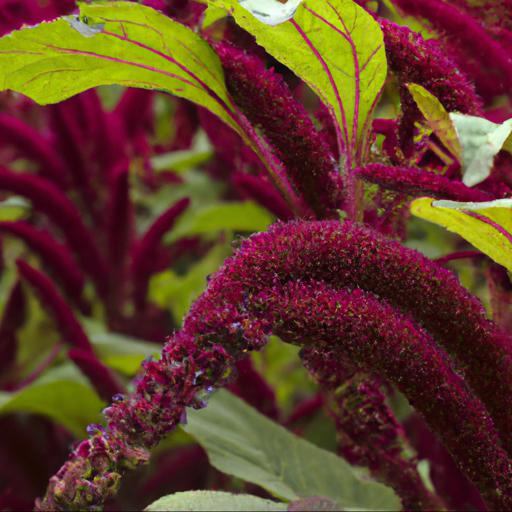Amaranthus caudatus, also known as love-lies-bleeding, is an ornamental plant that has been used in traditional medicine for centuries. It is believed to have many health benefits, including the ability to reduce inflammation, improve digestion, and boost the immune system. In this blog, we will explore the many uses of Amaranthus caudatus, as well as the potential side effects and safety precautions associated with its use.
We will also discuss the scientific evidence supporting its medicinal properties and the best ways to incorporate it into your daily diet. Finally, we will look at how Amaranthus caudatus is being used in modern medicine and the potential for it to become a mainstream treatment.
Nutritional benefits of amaranthus caudatus

As a UK garden expert, I cannot fail to mention the nutritional benefits of Amaranthus caudatus, an edible plant with its origins in the Americas. This plant is loved by gardeners for its stunning foliage; but what really sets it apart is its amazing nutritional content.
Amaranthus caudatus is a powerhouse of vitamins, minerals, and essential nutrients, making it a must-have for any vegetable patch. In terms of vitamins, each half cup serving of cooked amaranthus caudatus contains over 45% of your daily recommended dose of vitamin A and 10% of vitamin C. It’s also a great source of folate, vitamin K and calcium.
Minerals found in Amaranthus caudatus include manganese, copper, magnesium, and phosphorus. Manganese is important for boosting the metabolism of proteins and carbohydrates, while copper aids in healthy cell formation, and magnesium helps to regulate blood sugar. Phosphorus is essential for energy production and healthy bones.
Amaranthus caudatus also contains a number of essential nutrients such as dietary fiber, antioxidants, and polyphenols. The dietary fiber present in this plant helps keep you feeling fuller for longer and can help reduce cholesterol levels.
Its high polyphenol content can help protect against certain types of cancers, and its antioxidants can help boost the body’s natural defense system. Overall, Amaranthus caudatus is a great addition to any vegetable patch due to its amazing nutritional content.
Rich in vitamins and minerals, and containing essential nutrients, it’s the ideal choice for gardeners looking to get the most nutritional bang out of their garden.
Growing and harvesting amaranthus caudatus

When it comes to ornamental edibles, few plants are as breathtakingly beautiful or as nutrient dense as Amaranthus caudatus. Native to the Americas, this bushy, tangled flowering plant has been used for culinary and medicinal purposes for centuries. A member of the amaranth family, Amaranthus caudatus is easy to care for and, with the proper cultivation steps, can add a burst of tropical colors to any garden.
Growing Amaranthus caudatus is an easy endeavor, and with soil rich in the essential nutrients nitrogen, phosphorus, and potassium and kept consistently moist, the plant should thrive in full sun in the northern hemisphere or partial shade in the south. When the seedlings reach 4 inches tall, they should be thinned to one seedling in each 12-inch area, so they have enough room to grow.
Additionally, regular watering, weeding, and cutting back of flowers should keep the plant healthy and productive. Harvesting Amaranthus caudatus should begin a few weeks after the first blooms appear, which can range from brilliant pinks to neon oranges and greens. The leaves, stems, and flowers of the plant can all be harvested–whether for cooking or for dried flower arrangements.
The earlier the harvesting, the more tender the plant is, so timing should be taken into account when it comes to picking harvests for eating. Additionally, selecting smaller flowers, leaves, and stems will ensure more nutrient dense harvests.
If desired, cooked Amaranthus caudatus can be frozen up to 3 months, while harvested blooms can be dried and enjoyed for months to come.
Uses of amaranthus caudatus

Amaranthus caudatus is an ancient herb used for both its culinary and medicinal properties. It is also known as love-lies-bleeding, or tassel flower, due to its cascading tassels of deep red flowers. Native to Central and South America, it has been grown for centuries for its edible leaves and seeds, used commonly in salads and other dishes throughout the Americas.
Amaranthus caudatus is a great addition to any garden and can thrive in a variety of climates. In the garden, amaranthus is a great choice for border, container and hanging basket planting.
The quick-growing annual stands up to heat and blooms from late summer to the first frost. Warm sunlight and consistent watering will encourage its sprawling stems and colorful flowers.
The impressive height of the plant reaches around two feet and its length grows outward, up to four feet in length. In addition to being a colorful ornament in a garden, amaranthus also provides several culinary and medicinal uses. The leaves are excellent in salads and cooked dishes and the tiny seeds can be boiled and eaten whole or ground into flour.
The leaves are rich in vitamins A, C, and K, as well as iron and calcium. In addition, its high fiber content helps to ease digestion.
Amaranthus has also been used in traditional medicinal practices such as treating boils, skin inflammations, and eye disorders. Amaranthus adds a touch of beauty to any garden and provides countless nutritional and medicinal benefits. For those looking to explore all the herb has to offer, amaranthus caudatus is an excellent addition to any flower bed.
Health benefits of amaranthus caudatus
Amaranthus caudatus, also known as love-lies-bleeding – a somewhat poetic name – is an ornamental annual flower that has a surprising number of health benefits. It has been used in traditional medicine for thousands of years and is a popular choice for plant lovers looking to add a touch of beauty to their garden while gaining the added benefits of a natural health aid. In this article, I will be discussing the health benefits that Amaranthus caudatus has to offer.
First, the plant contains essential amino acids and essential fatty acids, which are vital for overall health. Amino acids help to aid in muscle growth, tissue repair, and enzyme production and fatty acids in particular can reduce inflammation, regulate cholesterol levels, and improve mental clarity.
It also contains minerals such as calcium, magnesium, and iron, all of which are important for bodily functions. Not to mention that it contains high amounts of antioxidants and carotenoids, substances that help to protect cells from free-radicals and oxidative damage caused by unstable molecules.
Second, Amaranthus caudatus is also rich in dietary fiber, which aids in digestion and helps to regulate blood sugar levels. As a result, this plant can reduce the risk of both diabetes and obesity. This can also aid in weight management, as fiber helps to slow digestion, allowing us to feel fuller for longer.
Finally, this plant has been used as a natural diuretic, meaning it can help to reduce water retention and bloating. This decrease in water weight can help you feel thinner and more energetic, and reduce many of the uncomfortable symptoms associated with conditions such as premenstrual syndrome.
Amaranthus caudatus is a beautiful, versatile plant with a wealth of health benefits. It has been used for centuries in traditional medicine, but is only now gaining wider attention for its nutritional and therapeutic benefits. So why not put the love-lies-bleeding to work in your garden and give your health a boost in the process?
Our video recommendation
Conclusion
Amaranthus caudatus, commonly known as love-lies-bleeding, is an annual flowering plant that is native to India and Africa. It is an ornamental plant with a long, cascading flower spike that can reach over two meters in length. The leaves are edible and the seeds are used as a grain crop.
The plant is drought tolerant and can be grown in a variety of soils. It is an important source of food and nutrition in many parts of the world.
A. caudatus is an important plant for its medicinal properties, with many traditional uses. It is also used in ayurvedic and traditional Chinese medicine.
FAQ
What is the scientific name of Amaranthus caudatus?
The scientific name of Amaranthus caudatus is Amaranthus caudatus L.
What are the common names of Amaranthus caudatus?
The common names of Amaranthus caudatus are love-lies-bleeding, tassel flower, and pendant amaranth.
What are the uses of Amaranthus caudatus?
Amaranthus caudatus is used as an ornamental plant, for medicinal purposes, and as a food crop. It is also used in traditional medicine to treat a variety of ailments, such as fever, headaches, and stomachaches. It is also used as a dye and to make jewelry.
Where is Amaranthus caudatus native to?
Amaranthus caudatus is native to Central and South America.
How is Amaranthus caudatus propagated?
Amaranthus caudatus is propagated by seed.
What are the nutritional benefits of Amaranthus caudatus?
Amaranthus caudatus is a nutrient-rich vegetable that is high in vitamins, minerals, and fiber. It is a good source of vitamins A, C, and K, as well as folate, iron, magnesium, and calcium. It is also a good source of dietary fiber, which can help promote digestive health and reduce cholesterol levels. Additionally, Amaranthus caudatus is low in calories and fat, making it a healthy addition to any diet.

